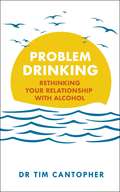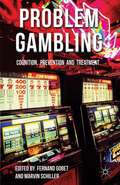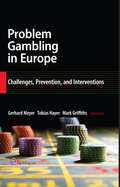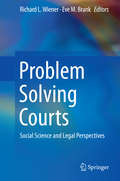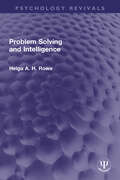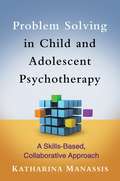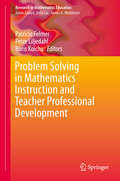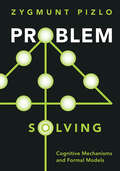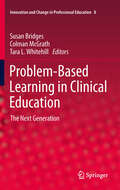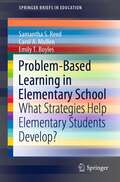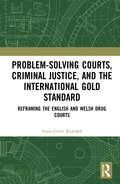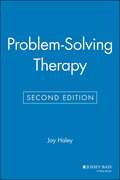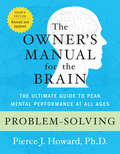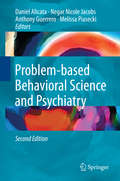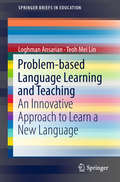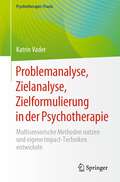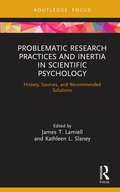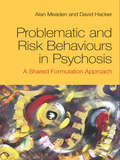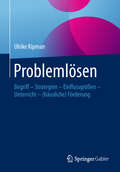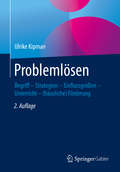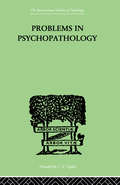- Table View
- List View
Problem Drinking: Rethinking Your Relationship with Alcohol
by Tim CantopherARE YOU REALLY IN CONTROL OF YOUR RELATIONSHIP WITH ALCOHOL?ARE YOU FINDING YOUR NEED TO DRINK GETTING STRONGER?DO YOU DEPEND ON ALCOHOL TO MANAGE DAILY LIFE? In his role as a consultant psychiatrist, Dr Tim Cantopher has worked with countless people to help them overcome dependency, and this book distils his decades of experience into a series of practical, achievable, straightforward steps to reduce your own intake, or give up altogether. Problem Drinking explains why you are drinking too much, what alcohol does to you physiologically, the influence of environment and personality, and the long-term consequences of alcohol addiction. It offers supportive strategies to help you cut down or do without, including advice on relaxation and sleep, problem-solving approaches, time management skills, and insight into drug treatments, the disease concept and the role of Alcoholics Anonymous.Read this book, take it one day at a time, and don't look back.
Problem Gambling
by Fernand Gobet Marvin SchillerProblem gambling is a perennial issue frequently reported in the media. This book is a comprehensive and up-to-date resource on problem gambling research. It describes the state of the art of the subject and presents the latest developments such as computer modelling of gambling behaviour and risk profiles of gambling products.
Problem Gambling in Europe
by Mark Griffiths Gerhard Meyer Tobias HayerProblem Gambling in Europe Challenges, Prevention, and Interventions Edited by Gerhard Meyer, University of Bremen, Germany Tobias Hayer, University of Bremen, Germany Mark Griffiths, Nottingham Trent University, United Kingdom As a leisure activity, gambling dates back to ancient times. More recently, the surge in avenues for gambling--casinos, sports betting, lotteries, and remote media (e.g.,Internet, mobile phone, interactive television) among them--finds growing numbers of people losing control over their gambling behaviour, usually at great personal and financial expense. Problem Gambling in Europe is the first book to offer a robust international knowledge base compiled by an interdisciplinary panel of researchers in gambling behaviour. Reports from 21 countries throughout Western, Eastern, Northern, and Southern Europe reveal wide variations in types of wagering activities, participation by populations, social and criminal consequences related to pathological gambling, the extent to which governments acknowledge the problem, and efforts to control it (often with the involvement of the gaming industries). For each country, noted experts discuss: Current legislation regulating gambling. Forms of gambling and their addictive potential. Participation rates and demographics. Prevalence of pathological gambling. National policies to address problem gambling. Prevention strategies and treatment methods. Problem Gambling in Europe brings insight and clarity to a widespread and complex phenomenon, and will be of considerable interest to all parties working to reduce their negative effects: social science researchers in addictions, gambling behaviour, and public health; clinical, social, and health psychologists and psychiatrists; treatment practitioners; the gaming industry; regulators; and policy makers.
Problem Posing: Reflections and Applications
by Stephen I. Brown Marion I. WalterAs a result of the editors' collaborative teaching at Harvard in the late 1960s, they produced a ground-breaking work -- The Art Of Problem Posing -- which related problem posing strategies to the already popular activity of problem solving. It took the concept of problem posing and created strategies for engaging in that activity as a central theme in mathematics education. Based in part upon that work and also upon a number of articles by its authors, other members of the mathematics education community began to apply and expand upon their ideas. This collection of thirty readings is a testimony to the power of the ideas that originally appeared. In addition to reproducing relevant materials, the editors of this book of readings have included a considerable amount of interpretive text which places the articles in the context of problem solving. While the preponderance of essays focus upon mathematics and mathematics education, some of them point to the relevance of problem posing to other fields such as biology or psychology. In the interpretive text that accompanies each chapter, they indicate how ideas expressed for one audience may be revisited or transformed in order to ready them for a variety of audiences.
Problem Solving Courts: Social Science and Legal Perspectives
by Richard L. Wiener Eve M. BrankIn order to make the criminal court system more effective there has been a growing trend to have courts participate in what is essentially a rehabilitation strategy. Such courts are often referred to as "problem-solving" because they are working on root causes of criminal behavior as part of the dispensation of justice. This major shift in the role of the courts means that the court works closely with prosecutors, public defenders, probation officers, social workers, and other justice system partners to develop a strategy that pressures offenders to complete a treatment program which will ultimately, hopefully prevent recidivism. Research has shown that this kind of strategy has a two-fold benefit. It has been successful in helping offenders turn their lives around which leads to improved public safety and the ultimate saving of public funds. This book is the first to focus exclusively on problem solving courts, and as such it presents an overview of the rationale and scientific evidence for such courts as well as individual sections on the key areas in which these courts are active. Thus there is specific attention paid to domestic violence, juvenile criminality, mental health, and more. Throughout, research findings are incorporated into general discussions of these courts operate and ideally what they are trying to accomplish. There is also discussion of how such courts should evolve in the future and the directions that further research should take.
Problem Solving and Intelligence (Psychology Revivals)
by Helga A. RoweOriginally published in 1985, Problem Solving and Intelligence was the result of the author’s efforts to understand the nature of human intelligence and the differences in the cognitive functioning of individuals which we observe again and again.The book contains two types of material. First it presents an overview of major contributions to the conceptualization and investigation of problem solving and intelligence, which was derived from the extensive, largely non-cumulative literature at the time. Second it reports a comprehensive, empirical study of the manifestation of intelligence in problem solving. The subject matter was at the interface of three traditional areas of psychological inquiry: namely, the study of cognitive processes, individual differences, and the characteristics of the stimulus. What was innovative is that intellectual performance is investigated in relation to the simultaneous operation of variables from these dimensions. The book was intended, primarily, as a contribution to the understanding and investigation of the nature of intelligent behavior, as well as an introduction to intelligence and problem solving. Today it can be read and enjoyed in its historical context.
Problem Solving in Child and Adolescent Psychotherapy
by Katharina ManassisThis highly accessible book presents clear steps for helping children and adolescents to develop and test out new solutions to specific social, emotional, or behavioral challenges. The author demonstrates how therapists of any orientation can implement problem solving as a stand-alone intervention or in combination with other therapeutic techniques. Extensive clinical examples illustrate what the approach looks like in action with kids of different ages; how it increases their confidence, independence, and resilience; and ways to involve parents. Strategies for overcoming frequently encountered obstacles to problem solving are highlighted throughout.
Problem Solving in Mathematics Instruction and Teacher Professional Development (Research in Mathematics Education)
by Peter Liljedahl Patricio Felmer Boris KoichuRecent research in problem solving has shifted its focus to actual classroom implementation and what is really going on during problem solving when it is used regularly in classroom. This book seeks to stay on top of that trend by approaching diverse aspects of current problem solving research, covering three broad themes. Firstly, it explores the role of teachers in problem-solving classrooms and their professional development, moving onto—secondly—the role of students when solving problems, with particular consideration of factors like group work, discussion, role of students in discussions and the effect of students’ engagement on their self-perception and their view of mathematics. Finally, the book considers the question of problem solving in mathematics instruction as it overlaps with problem design, problem-solving situations, and actual classroom implementation. The volume brings together diverse contributors from a variety of countries and with wide and varied experiences, combining the voices of leading and developing researchers. The book will be of interest to any reader keeping on the frontiers of research in problem solving, more specifically researchers and graduate students in mathematics education, researchers in problem solving, as well as teachers and practitioners.
Problem Solving: Cognitive Mechanisms and Formal Models
by Zygmunt PizloIntelligent mental representations of physical, cognitive and social environments allow humans to navigate enormous search spaces, whose sizes vastly exceed the number of neurons in the human brain. This allows us to solve a wide range of problems, such as the Traveling Salesperson Problem, insight problems, as well as mathematics and physics problems. As an area of research, problem solving has steadily grown over time. Researchers in Artificial Intelligence have been formulating theories of problem solving for the last 70 years. Psychologists, on the other hand, have focused their efforts on documenting the observed behavior of subjects solving problems. This book represents the first effort to merge the behavioral results of human subjects with formal models of the causative cognitive mechanisms. The first coursebook to deal exclusively with the topic, it provides a main text for elective courses and a supplementary text for courses such as cognitive psychology and neuroscience.
Problem Solving: Perspectives from Cognition and Neuroscience
by S. Ian RobertsonThe way that we assess and overcome problems is an essential part of everyday life. Problem Solving provides a clear introduction to the underlying mental processes involved in solving problems. Drawing on research from cognitive psychology and neuroscience, it examines the methods and techniques used by both novices and experts in familiar and unfamiliar situations. This edition has been comprehensively updated throughout, and now features cutting-edge content on creative problem solving, insight and neuroscience. Each chapter is written in an accessible way, and contains a range of student-friendly features such as activities, chapter summaries and further reading. The book also provides clear examples of studies and approaches that help the reader fully understand important and complex concepts in greater detail. Problem Solving fully engages the reader with the difficulties and methodologies associated with problem solving. This book will be of great use to undergraduate students of cognitive psychology, education and neuroscience, as well as readers and professionals with an interest in problem solving.
Problem-Based Learning in Clinical Education: The Next Generation
by Susan Bridges Tara L. Whitehill Colman McgrathDeveloped in the context of health sciences education in the late 1960s, problem-based learning (PBL) is now widely deployed as an education methodology. Its problem-solving, collaborative, student-centred ethos is seen as a more appropriate system of pedagogy than earlier 'chalk-and-talk' modes. Focusing on its use in clinical education, this collection of recent scholarship on PBL examines the ways in which PBL is both conceived and implemented in clinical education. The work has a dual emphasis, research-driven on the one hand, while on the other assessing new methodologies to explore how problem-based curricula support the achievement of students' learning outcomes in the context of clinical education. The chapters draw on studies that explore PBL both theoretically and empirically. The volume's eclecticism capitalises on the growing body of empirical research into PBL evaluations. It balances this with studies analysing the relatively new area of discourse-based research on PBL-in-action, whose focus has been to interrogate the 'how' of student learning in curricula with PBL content.This publication will be of interest to clinical teachers, curriculum designers and those interested in innovations in the scholarship of teaching and learning in PBL curricula.
Problem-Based Learning in Elementary School: What Strategies Help Elementary Students Develop? (SpringerBriefs in Education)
by Carol A. Mullen Samantha S. Reed Emily T. BoylesThis book addresses Problem-based Learning (PBL) in elementary schools and reveals how this can promote elementary students’ development in critical thinking, creativity, communication, collaboration, and citizenship, also known as the 5 Cs. Through teachers’ interviews, the book explores which PBL strategies promote skills and knowledge gains when students collaboratively investigate authentic open-ended problems. It also uncovers peer-to-peer relational learning and other strategies used in PBL classrooms, and it examines their importance to public education. The book paints a lively picture of student-centered learning, drawing upon frameworks, best practices, experiences, processes, strategies, and research results. Firsthand accounts of best practices in PBL instruction connect this pedagogy to theory, research, practice, and policy. It explores teacher instruction in the early years of schooling that purposefully fosters student-centered learning, real-world relevance, and collaboration in accordance with capacities expected of successful 21st century graduates. This book supports the implementation of PBL in elementary schools and promotes increased student engagement and achievement, as well as college and career readiness. This book is of interest to practitioners seeking information about PBL pedagogies for elementary grades, such as teachers, teacher mentors and trainers, (school) leaders, and policymakers, as well as anyone interested in pedagogic strategies that advance critical thinking, creativity, communication, collaboration, and citizenship capacities.
Problem-Solving Courts, Criminal Justice, and the International Gold Standard: Reframing the English and Welsh Drug Courts
by Anna Grace KawałekThis book presents findings from a process evaluation carried out at a problem-solving court located in England: Manchester Review Court. Unlike the widely documented successes of similar international models, there is no detail of Manchester Review Court in the accessible literature, not in any policy document, nor is there a court handbook or website outlining objectives and expected practice. In adopting the seminal ‘wine’ and ‘bottle’ analytical framework propounded by therapeutic jurisprudence scholars, and by carrying out a detailed comparative analysis comparing the court to successful international problem-solving courts, the original empirical data brings clarity to an overlooked area. A fidelity analysis is also offered for the forerunning English and Welsh drug courts, which were established during the early 2000s, but then shortly fell by the wayside without satisfactory explanation for why. Findings from the book shed new light on the causes of the English and Welsh drug court downfalls pending recent calls to roll out a fresh suite of problem-solving courts. In light of the international evidence base and national struggles in the field, the book proposes a renewed, UK-specific, fidelity matrix to forge the impetus for new practice in this area, whilst accounting for past failures and acknowledging current issues. Therefore, this book not only breaks new ground by advancing knowledge of a significantly uncharted area but provides important inroads for helping policymakers with their strategies in tackling recidivism, addiction, victimisation, and austerity, as widespread social and human issues currently facing both Manchester and the UK more broadly. Presenting significant advancements in theory, policy, and practice at both national and international scale, the book will be a valuable resource for academics and practitioners working in the fields of Therapeutic Justice, Criminal Law, Criminology, Criminal Justice, and Socio-Legal Studies.
Problem-Solving Therapy
by Jay HaleyA classic that teaches you how to think in a contextually sensitive, directive, and goal-focused way. A highly readable and practical volume that focuses on solving problems within the context of the entire social unit--the family, the school, the community.
Problem-Solving: The Owner's Manual
by Pierce HowardCutting-edge, user-friendly, and comprehensive: the revolutionary guide to the brain, now fully revised and updatedAt birth each of us is given the most powerful and complex tool of all time: the human brain. And yet, as we well know, it doesn't come with an owner's manual--until now. In this unsurpassed resource, Dr. Pierce J. Howard and his team distill the very latest research and clearly explain the practical, real-world applications to our daily lives. Drawing from the frontiers of psychology, neurobiology, and cognitive science, yet organized and written for maximum usability, The Owner's Manual for the Brain, Fourth Edition, is your comprehensive guide to optimum mental performance and well-being. It should be on every thinking person's bookshelf. What are the ingredients of happiness? Which are the best remedies for headaches and migraines? How can we master creativity, focus, decision making, and willpower? What are the best brain foods? How is it possible to boost memory and intelligence? What is the secret to getting a good night's sleep? How can you positively manage depression, anxiety, addiction, and other disorders? What is the impact of nutrition, stress, and exercise on the brain? Is personality hard-wired or fluid? What are the best strategies when recovering from trauma and loss? How do moods and emotions interact? What is the ideal learning environment for children? How do love, humor, music, friendship, and nature contribute to well-being? Are there ways of reducing negative traits such as aggression, short-temperedness, or irritability? What is the recommended treatment for concussions? Can you delay or prevent Alzheimer's and dementia? What are the most important ingredients to a successful marriage and family? What do the world's most effective managers know about leadership, motivation, and persuasion? Plus 1,000s more topics!
Problem-based Behavioral Science and Psychiatry
by Daniel Alicata Negar Jacobs Anthony Guerrero Melissa PiaseckiIn keeping with the growing emphasis on psychiatry in the medical school curriculum, problem-based learning (PBL) offers students a unique patient-centred, multidisciplinary approach to study and the synthesis of knowledge. The new 2nd edition of Problem-Based Behavioral Science and Psychiatry integrates DSM-5 updates and diagnostic criteria, and is fully consistent with PBL models and methods. Building on the strengths of the popular and widely downloaded 1st edition, the 2nd edition is a clinically robust resource for both the medical and the behavioral science student. Over 40 contributors, many themselves graduates of PBL medical schools, apply problem-based learning methods to specific psychiatric disorders, general clinical issues, and bedrock physician skills such as the intake interview and treatment planning. The book's fictional case vignettes illustrated typical patient scenarios, providing real-world context for content areas, and accompanying case diagrams show the relationships between patient behaviour and underlying neurobiological structures. Each student-friendly section ends with helpful review questions. A sampling of the content areas covered: · Childhood development and brain development. · Major psychiatric illnesses, including personality, mood, anxiety, and psychotic disorders. · Stress, substance abuse, and violence. · Eating, sleep, and sexual disorders. · Coping skills and treatment compliance. · End-of-life care. · PLUS chapters on cultural sensitivity, ethical concerns, and the physician/patient relationship. This book is ideal for first and second year medical students wanting to learn about psychiatry in the exciting context of realistic cases. It also makes an excellent prep/review text for third- and fourth-year medical students preparing for the USMLE Step 1 and 2 exams, as well as being suited to graduate students in psychology or clinical social work. Problem-Based Behavioral Science and Psychiatry encourages lifelong learning and helps build the foundation for a lifelong career.
Problem-based Language Learning and Teaching: An Innovative Approach to Learn a New Language (SpringerBriefs in Education)
by Loghman Ansarian Mei Lin TeohThis book investigates how problem-based learning can be implemented in language classes and how it can bring about a change in language learners' understanding of the foreign language. Based on empirical evidence, it provides readers with the theoretical background of this interdisciplinary approach in education, discusses the challenges that language teachers might encounter while implementing this approach in language classes, and offers procedures for employing the method. It also clarifies the difference between collaborative learning and problem-based learning in which certain dynamics are at work. It is of interest to researchers and instructors in cognitive learning, task-based language teaching, and content-focused courses.
Problemanalyse, Zielanalyse, Zielformulierung in der Psychotherapie: Multisensorische Methoden nutzen und eigene Impact-Techniken entwickeln (Psychotherapie: Praxis)
by Katrin VaderIn diesem Praxisbuch wird der Bedeutsamkeit der Problem- und Zielanalyse und Zielformulierung in der Psychotherapie als Fundament einer Behandlung dadurch Rechnung getragen, dass sich alle Fallbeispiele auf diese Bereiche beziehen. Als passionierte Impact-Technik-Anwenderin beschreibt die Autorin jede eingesetzte Übung von der Idee bis zur Durchführung. Impact-Techniken sind multisensorische Elemente aus verschiedenen Therapierichtungen und dadurch kraftvolle und nachhaltige Arbeitsmethoden. Sie sind therapieschulenübergreifend, unabhängig vom Alter und von Beschwerdebildern einsetzbar. Attraktiv an diesen Techniken sind die Einfachheit der Durchführung und dass alle in der Umgebung zur Verfügung stehenden Gegenstände als Arbeitsmittel benutzt werden können. Durch die zahlreichen Anwendungsbeispiele von Impact-Techniken in diesem Buch soll der Transfer vom Gelesenen in den eigenen Behandlungsalltag unterstützt werden. Aus dem Inhalt: Trotz Bemühungen erreicht der Patient sein Ziel lange nicht, der Therapieverlauf stagniert trotz vorhandener hilfreicher Strategien. Verstrickungen sichtbar machen und auflösen, unklare Therapieziele konkretisieren, Therapiemotivation klären. Über die Autorin: Dipl.-Psych. Katrin Vader ist niedergelassene Psychotherapeutin für Erwachsene (Schwerpunkt Verhaltenstherapie) in eigener Praxis in Jena. Lehrpraxis, Supervisorin, Selbsterfahrungsleiterin und Dozentin für verschiedene psychotherapeutische Ausbildungsinstitute in Deutschland.
Problematic Research Practices and Inertia in Scientific Psychology: History, Sources, and Recommended Solutions
by James T. LamiellThis volume explores the abiding intellectual inertia in scientific psychology in relation to the discipline’s engagement with problematic beliefs and assumptions underlying mainstream research practices, despite repeated critical analyses which reveal the weaknesses, and in some cases complete inappropriateness, of these methods. Such paradigmatic inertia is especially troublesome for a scholarly discipline claiming status as a science. The book offers penetrating analyses of many (albeit not all) of the most important areas where mainstream practices require either compelling justifications for their continuation or adjustments – possibly including abandonment – toward more apposite alternatives. Specific areas of concern addressed in this book include the systemic misinterpretation of statistical knowledge; the prevalence of a conception of measurement at odds with yet purporting to mimic the natural sciences; the continuing widespread reliance on null hypothesis testing; and the continuing resistance within psychology to the explicit incorporation of qualitative methods into its methodological toolbox. Broader level chapters examine mainstream psychology’s systemic disregard for critical analysis of its tenets, and the epistemic and ethical problems this has created. This is a vital and engaging resource for researchers across psychology, and those in the wider behavioural and social sciences who have an interest in, or who use, psychological research methods.
Problematic and Risk Behaviours in Psychosis: A Shared Formulation Approach
by Alan Meaden David HackerIn spite of improved access to psychosocial interventions, many people with psychosis continue to experience persistent problems which act as significant barriers to their recovery. This book investigates risk and problem behaviours in psychosis, including staff and service factors that can impede the delivery of effective care. Problematic and Risk Behaviours in Psychosis provides a new approach for assessment, formulation and intervention within such problem behaviours in a team context. Of particular interest will be: an outline of the SAFE (Shared Assessment, Formulation and Education) approach an integrative model for understanding risk and problematic behaviour shared risk assessment and management processes approaches to reducing team and carer barriers to effective care the use of CBT in day-to-day interactions with clients a set of formulation-driven strategies for managing problematic behaviours case studies and vignettes providing guidance and highlighting the benefits of the approach. This book will have particular appeal to professionals working in specialist community, hospital-based and residential services who often struggle to help those with the most complex mental health problems who are hardest to reach. It is also an excellent resource for those engaged in training in psychological therapies, risk assessment and management.
Problemlösen: Begriff – Strategien – Einflussgrößen – Unterricht – (häusliche) Förderung
by Ulrike KipmanProblemlösen gilt als eine der Schlüsselqualifikationen des 21. Jahrhunderts. Es geht beim Problemlösen nicht nur darum, Informationen sinnvoll zu vernetzen, dynamisch in Beziehung zu setzen, Wahrscheinlichkeiten zu berechnen und eine Kette richtiger Entscheidungen zu treffen, sondern auch vielfach darum, eine Vielzahl an Außenkriterien zu berücksichtigen und ein entsprechendes „Weltwissen“ an den Tag zu legen. Dieses Buch soll die Frage beantworten, wie man zu einem guten Problemlöser / einer guten Problemlöserin werden kann bzw. warum bestimmte Personen bei der Lösung von Problemen erfolgreicher sind als andere. Nach einer umfassenden Zusammenstellung der Literatur zu diesem Thema werden Einflussgrößen auf das Problemlösen analysiert und miteinander abgeglichen und Ideen für den Unterricht in der Primarstufe und Sekundarstufe I präsentiert. Zudem werden verschiedene Arten des Unterrichts im Hinblick auf die Wirksamkeit für unterschiedliche Personengruppen diskutiert, dies vor dem Hintergrund, dass nicht nur Problemstellungen stark variieren sondern auch die Problemlöser/innen. Eine Handreichung mit Brettspielen, die die Kriterien des Problemlösens erfüllen, ist ebenfalls Teil dieses Buches. Letztendlich wird ein Modell vorgeschlagen, welches erfolgreiches Problemlösen vielschichtig zu erklären versucht.
Problemlösen: Begriff – Strategien – Einflussgrößen – Unterricht – (häusliche) Förderung
by Ulrike KipmanProblemlösen gilt als eine der Schlüsselqualifikationen des 21. Jahrhunderts. Es geht beim Problemlösen nicht nur darum, Informationen sinnvoll zu vernetzen, dynamisch in Beziehung zu setzen, Wahrscheinlichkeiten zu berechnen und eine Kette richtiger Entscheidungen zu treffen, sondern auch vielfach darum, eine Vielzahl an Außenkriterien zu berücksichtigen und ein entsprechendes „Weltwissen“ an den Tag zu legen. Dieses Buch soll die Frage beantworten, wie man zu einem guten Problemlöser / einer guten Problemlöserin werden kann bzw. warum bestimmte Personen bei der Lösung von Problemen erfolgreicher sind als andere. Nach einer umfassenden Zusammenstellung der Literatur zu diesem Thema werden Einflussgrößen auf das Problemlösen analysiert und miteinander abgeglichen und Ideen für den Unterricht in der Primarstufe und Sekundarstufe I präsentiert. Zudem werden verschiedene Arten des Unterrichts im Hinblick auf die Wirksamkeit für unterschiedliche Personengruppen diskutiert, dies vor dem Hintergrund, dass nicht nur Problemstellungen stark variieren sondern auch die Problemlöser/innen. Eine Handreichung mit Brettspielen, die die Kriterien des Problemlösens erfüllen, ist ebenfalls Teil dieses Buches. Letztendlich wird ein Modell vorgeschlagen, welches erfolgreiches Problemlösen vielschichtig zu erklären versucht. In der 2. Auflage wurden alle Kapitel überarbeitet und an den neuesten Kenntnisstand zum Thema Problemlösen angepasst. Die Kapitel zur schulischen und häuslichen Förderung der Problemlösekompetenz wurden stark erweitert und es werden nun eine Vielzahl an neuen Aufgaben und Spielen präsentiert, die beim Fördern von Problemlösen eine wertvolle Unterstützung leisten können. Das Kapitel zur Kombinatorik wurde nach der Rückmeldung von Studierenden und Kollegen komplett umstrukturiert und ist nun verständlicher und übersichtlicher aufgebaut.
Problems in Psychopathology
by T.W. MitchellFirst Published in 1999. Routledge is an imprint of Taylor & Francis, an informa company.
Problems of Historical Psychology (Psychology Library Editions: History of Psychology)
by Zevedei BarbuOriginally published in 1960, this study was rooted in the conviction that a close cooperation between the disciplines of psychology and history opened new and fruitful perspectives for the understanding of both fields. The title is an investigation of the connection between history and psychology, discussing how a society shapes and conditions the minds of those born into it. The author takes a close look at Greek society at the time of Pericles, and English society of the Elizabethan era. Though presented in the idiom of psychology, the problems with which this book is concerned, should appeal to historian and psychologist alike.
Problems of Human Pleasure and Behaviour
by Michael BalintMichael Balint addresses himself to a variety of subjects of interest to both the layman and the practicing clinical psychologist or psychiatrist: among others, sex and society, masturbation, discipline, menstruation, punishment, aging, and parapsychology.
